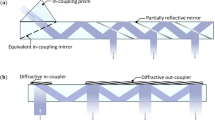Abstract
A free-form lens (FFL) is a special surface that is difficult to be fabricated. FFL are usually fabricated by computer-controlled optical surfacing (CCOS) technique. During CCOS, the material removal amount is determined by the unit removal function (URF) convoluting with the input data — the dwell time. When the removal amount and the URF are known, how to solve the input data involves the special algorithm — deconvolution. Usually, the input data are solved by virtue of low pass filter or iterative methods. However, an approximation solution would destroy the machining stability necessary to perform precisely CCOS. In this paper, to solve the input data, a new method that is based on the finite Fourier coefficient is put forward. It can give a continuous and accurate solution for fabricating choice. Several parameters are simulated, which influence the process of CCOS, and evaluating on the effect of the method is also carried out. Experimental results verify that this method is suitable for guiding the manufacturing of high precision FFL.
Similar content being viewed by others
References
Bogdanov, A. P., Dushkin, V. A., Mikhailova, L. N. et al., Ion-beam shaping of high-precision optical surfaces by a small-diameter, program-positioned ion beam, J. Opt. Technol, 1994, 61(6): 474–477.
Rupp, W. J., Loose abrasive grinding of optical surfaces, Applied Optics, 1972, 11(12): 2797–2810.
Sun, T., Yan, Y. D., Gao, D. Z. et al., Processing technique of target capsule’s micro inflation hole with a scanning probe, Science in China, Seriers E, 2004, 47(1): 77–84.
Jones, R. A., Rupp, W. J., Rapid optical fabrication with computer-controlled optical surfacing, Opt. Eng., 1991, 30: 1962–1969.
Kirk, N. B., Wood, J. V., Glass polishing, Br. Cream. Trans, 1994, 93: 25–30.
Soares, S. F., Baseit, D. R., Black, J. P. et al., Float-polishing process and analysis of float-polished quartz, Applied Optics, 1994, 33: 89–95.
Mori, Y., Yamauchi, K., Endo, K., Mechanism of atomic removal in elastic emission machining, Precis. Eng., 1988, 10: 24–28.
Greg, P., Automating lens manufacturing, Mechanical Engineering, 1997, 119(3): 88–91.
Suzuki, H., Hara, S., Matsunaga, H., Study on aspherical surface polishing using a small rotating tool-development of polishing system, J. Jpn Soc. Precis. Eng., 1993, 59(10): 1713–1717.
Feng, Z. J., Wu, H. Z., Zhao, G. M. et al., Correcting the accuracy of nonrotating and aspheric lens by control-ling the pressure of the polishing die, Journal of Tsinghua University (in Chinese), 2000, 40(8): 69–72.
Mahito, N., Manabu, A., Studies on super-smooth polishing-deconvolution algorithm for corrective polishing, Journal of the JSPE, 1996, 62(3): 408–412.
Ronald, A., Ralph, M., Francis, R. N., Computer assisted optical surfacing, Applied Optics, 1972, 11(12): 2739–2747.
Jones, R. A., Optimization of computer controlled polishing, Applied Optics, 1977, 16(1): 218–224.
Author information
Authors and Affiliations
Corresponding author
Rights and permissions
About this article
Cite this article
Cheng, H., Sun, G. & Feng, Z. Solving the input data in error correction of optical fabrication by finite Fourier coefficient algorithm. SCI CHINA SER E 49, 50–60 (2006). https://doi.org/10.1007/s11431-004-5141-6
Received:
Accepted:
Issue Date:
DOI: https://doi.org/10.1007/s11431-004-5141-6




